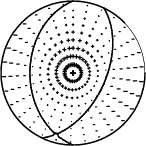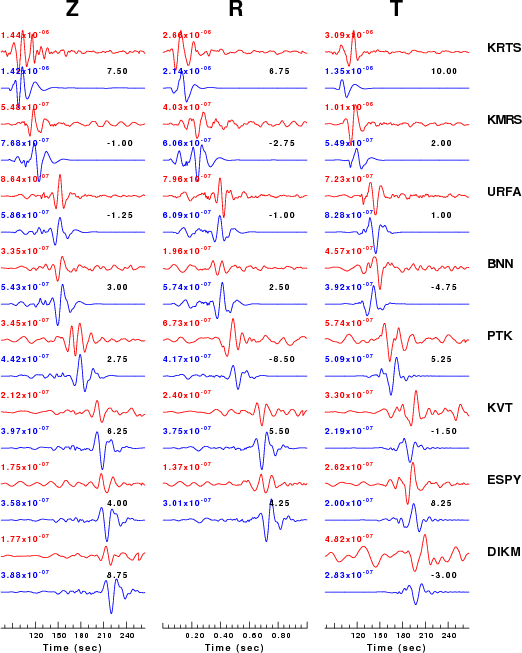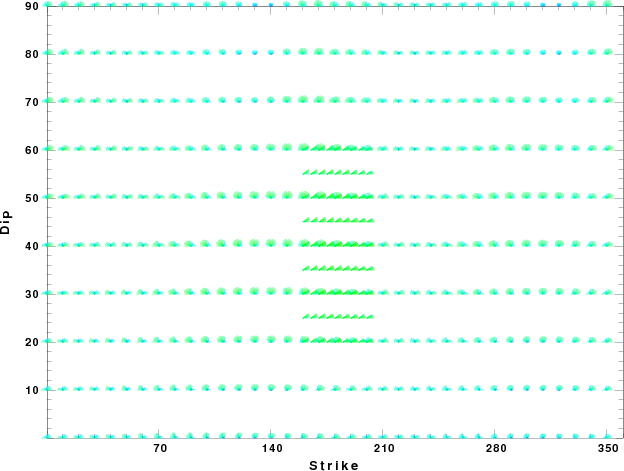
2009/06/17 04:29:18 36.1000 35.9300 20.0 4.60 Turkey
USGS Felt map for this earthquake
USGS/SLU Moment Tensor Solution
ENS 2009/06/17 04:29:18:0 36.10 35.93 20.0 4.6 Turkey
Stations used:
KO.BNN KO.DIKM KO.ESPY KO.KMRS KO.KRTS KO.KVT KO.PTK
KO.URFA
Filtering commands used:
hp c 0.02 n 3
lp c 0.05 n 3
Best Fitting Double Couple
Mo = 5.75e+22 dyne-cm
Mw = 4.44
Z = 18 km
Plane Strike Dip Rake
NP1 25 53 106
NP2 180 40 70
Principal Axes:
Axis Value Plunge Azimuth
T 5.75e+22 76 347
N 0.00e+00 13 196
P -5.75e+22 7 104
Moment Tensor: (dyne-cm)
Component Value
Mxx -2.21e+15
Mxy 1.27e+22
Mxz 1.51e+22
Myy -5.33e+22
Myz -9.39e+21
Mzz 5.33e+22
----##########
------###############-
-------#################----
-------###################----
--------####################------
--------#####################-------
--------######################--------
--------#######################---------
--------########## ##########---------
---------########## T ##########----------
---------########## #########-----------
---------######################-----------
---------#####################-------- -
--------####################--------- P
--------###################----------
--------#################-------------
--------###############-------------
--------############--------------
-------#########--------------
-------######---------------
----------------------
####----------
Global CMT Convention Moment Tensor:
R T P
5.33e+22 1.51e+22 9.39e+21
1.51e+22 -2.21e+15 -1.27e+22
9.39e+21 -1.27e+22 -5.33e+22
Details of the solution is found at
http://www.eas.slu.edu/Earthquake_Center/MECH.NA/20090617042918/index.html
|
STK = 180
DIP = 40
RAKE = 70
MW = 4.44
HS = 18.0
The waveform inversion is preferred.
The following compares this source inversion to others
USGS/SLU Moment Tensor Solution
ENS 2009/06/17 04:29:18:0 36.10 35.93 20.0 4.6 Turkey
Stations used:
KO.BNN KO.DIKM KO.ESPY KO.KMRS KO.KRTS KO.KVT KO.PTK
KO.URFA
Filtering commands used:
hp c 0.02 n 3
lp c 0.05 n 3
Best Fitting Double Couple
Mo = 5.75e+22 dyne-cm
Mw = 4.44
Z = 18 km
Plane Strike Dip Rake
NP1 25 53 106
NP2 180 40 70
Principal Axes:
Axis Value Plunge Azimuth
T 5.75e+22 76 347
N 0.00e+00 13 196
P -5.75e+22 7 104
Moment Tensor: (dyne-cm)
Component Value
Mxx -2.21e+15
Mxy 1.27e+22
Mxz 1.51e+22
Myy -5.33e+22
Myz -9.39e+21
Mzz 5.33e+22
----##########
------###############-
-------#################----
-------###################----
--------####################------
--------#####################-------
--------######################--------
--------#######################---------
--------########## ##########---------
---------########## T ##########----------
---------########## #########-----------
---------######################-----------
---------#####################-------- -
--------####################--------- P
--------###################----------
--------#################-------------
--------###############-------------
--------############--------------
-------#########--------------
-------######---------------
----------------------
####----------
Global CMT Convention Moment Tensor:
R T P
5.33e+22 1.51e+22 9.39e+21
1.51e+22 -2.21e+15 -1.27e+22
9.39e+21 -1.27e+22 -5.33e+22
Details of the solution is found at
http://www.eas.slu.edu/Earthquake_Center/MECH.NA/20090617042918/index.html
|
The focal mechanism was determined using broadband seismic waveforms. The location of the event and the and stations used for the waveform inversion are shown in the next figure.

|
|
|
The program wvfgrd96 was used with good traces observed at short distance to determine the focal mechanism, depth and seismic moment. This technique requires a high quality signal and well determined velocity model for the Green functions. To the extent that these are the quality data, this type of mechanism should be preferred over the radiation pattern technique which requires the separate step of defining the pressure and tension quadrants and the correct strike.
The observed and predicted traces are filtered using the following gsac commands:
hp c 0.02 n 3 lp c 0.05 n 3The results of this grid search from 0.5 to 19 km depth are as follow:
DEPTH STK DIP RAKE MW FIT
WVFGRD96 0.5 10 45 85 4.09 0.2332
WVFGRD96 1.0 15 45 85 4.12 0.2238
WVFGRD96 2.0 10 45 85 4.22 0.2734
WVFGRD96 3.0 200 50 100 4.24 0.2292
WVFGRD96 4.0 305 35 25 4.28 0.2475
WVFGRD96 5.0 305 35 25 4.30 0.2869
WVFGRD96 6.0 310 40 35 4.31 0.3173
WVFGRD96 7.0 310 40 30 4.31 0.3513
WVFGRD96 8.0 310 30 30 4.38 0.3694
WVFGRD96 9.0 130 30 -25 4.36 0.3945
WVFGRD96 10.0 130 35 -35 4.37 0.4174
WVFGRD96 11.0 125 35 -40 4.38 0.4353
WVFGRD96 12.0 125 35 -40 4.39 0.4492
WVFGRD96 13.0 120 35 -45 4.39 0.4581
WVFGRD96 14.0 115 35 -45 4.40 0.4640
WVFGRD96 15.0 185 40 75 4.44 0.4684
WVFGRD96 16.0 180 40 70 4.44 0.4762
WVFGRD96 17.0 180 40 70 4.44 0.4814
WVFGRD96 18.0 180 40 70 4.44 0.4838
WVFGRD96 19.0 175 40 65 4.44 0.4832
WVFGRD96 20.0 175 40 65 4.44 0.4816
WVFGRD96 21.0 175 40 60 4.45 0.4796
WVFGRD96 22.0 170 40 55 4.45 0.4759
WVFGRD96 23.0 170 40 55 4.45 0.4713
WVFGRD96 24.0 165 45 45 4.45 0.4660
WVFGRD96 25.0 165 45 45 4.45 0.4607
WVFGRD96 26.0 165 45 45 4.46 0.4548
WVFGRD96 27.0 160 45 40 4.46 0.4489
WVFGRD96 28.0 160 45 40 4.46 0.4417
WVFGRD96 29.0 160 45 40 4.47 0.4356
The best solution is
WVFGRD96 18.0 180 40 70 4.44 0.4838
The mechanism correspond to the best fit is

|
|
|
The best fit as a function of depth is given in the following figure:

|
|
|
The comparison of the observed and predicted waveforms is given in the next figure. The red traces are the observed and the blue are the predicted. Each observed-predicted componnet is plotted to the same scale and peak amplitudes are indicated by the numbers to the left of each trace. The number in black at the rightr of each predicted traces it the time shift required for maximum correlation between the observed and predicted traces. This time shift is required because the synthetics are not computed at exactly the same distance as the observed and because the velocity model used in the predictions may not be perfect. A positive time shift indicates that the prediction is too fast and should be delayed to match the observed trace (shift to the right in this figure). A negative value indicates that the prediction is too slow. The bandpass filter used in the processing and for the display was
hp c 0.02 n 3 lp c 0.05 n 3

|
|
|

|
| Focal mechanism sensitivity at the preferred depth. The red color indicates a very good fit to thewavefroms. Each solution is plotted as a vector at a given value of strike and dip with the angle of the vector representing the rake angle, measured, with respect to the upward vertical (N) in the figure. |
The WUS used for the waveform synthetic seismograms and for the surface wave eigenfunctions and dispersion is as follows:
MODEL.01
Model after 8 iterations
ISOTROPIC
KGS
FLAT EARTH
1-D
CONSTANT VELOCITY
LINE08
LINE09
LINE10
LINE11
H(KM) VP(KM/S) VS(KM/S) RHO(GM/CC) QP QS ETAP ETAS FREFP FREFS
1.9000 3.4065 2.0089 2.2150 0.302E-02 0.679E-02 0.00 0.00 1.00 1.00
6.1000 5.5445 3.2953 2.6089 0.349E-02 0.784E-02 0.00 0.00 1.00 1.00
13.0000 6.2708 3.7396 2.7812 0.212E-02 0.476E-02 0.00 0.00 1.00 1.00
19.0000 6.4075 3.7680 2.8223 0.111E-02 0.249E-02 0.00 0.00 1.00 1.00
0.0000 7.9000 4.6200 3.2760 0.164E-10 0.370E-10 0.00 0.00 1.00 1.00
Here we tabulate the reasons for not using certain digital data sets
The following stations did not have a valid response files:
DATE=Wed Jun 17 16:02:53 CDT 2009